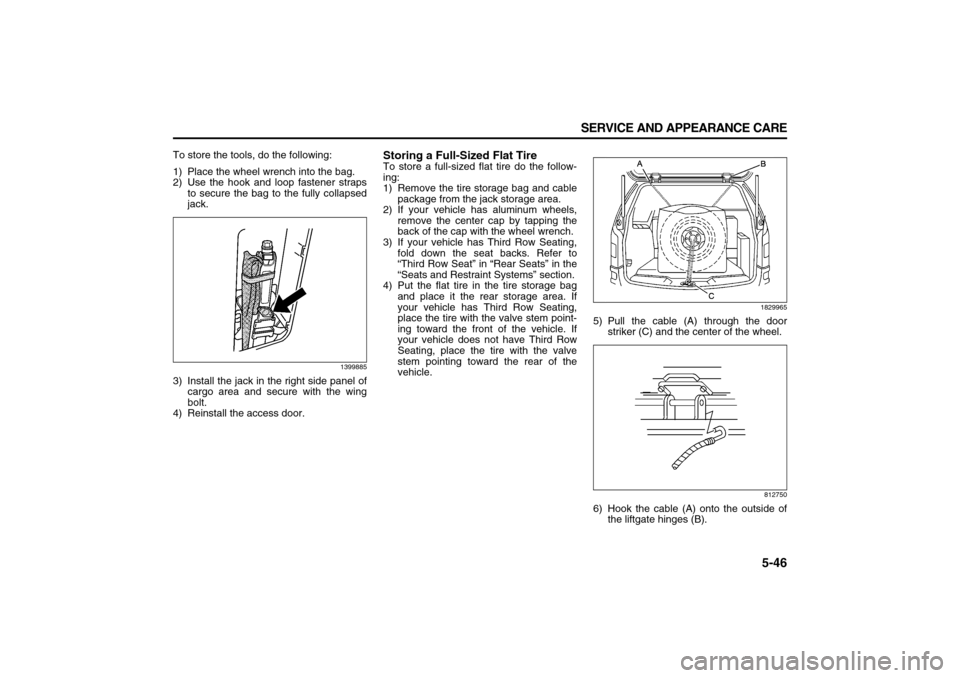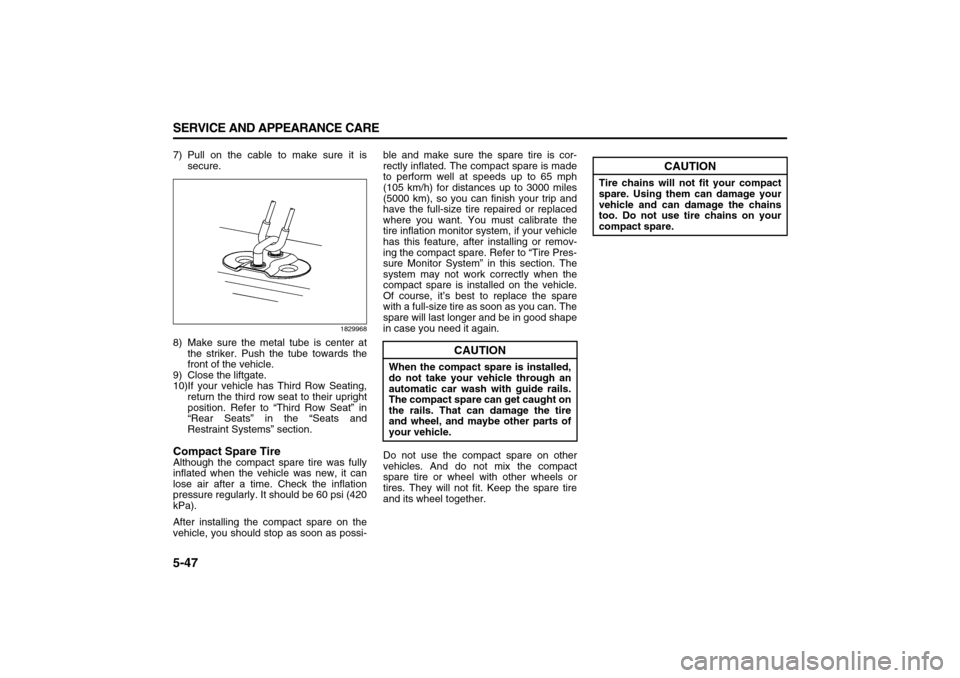2007 SUZUKI XL7 seats
[x] Cancel search: seatsPage 159 of 274

4-1 DRIVING YOUR VEHICLE
78J00-03E
Your Driving, the Road, and
Your VehicleDefensive DrivingThe best advice anyone can give about
driving is: Drive defensively.
Please start with a very important safety
device in your vehicle: Buckle up. Refer to
“Safety Belts: They Are for Everyone” in
“Safety Belts” in the “Seats and Restraint
Systems” section.
Drunken DrivingDeath and injury associated with drinking
and driving is a national tragedy. It is the
number one contributor to the highway
death toll, claiming thousands of victims
every year.
Alcohol affects four things that anyone
needs to drive a vehicle:
Judgment
Muscular Coordination
Vision
Attentiveness
Police records show that almost half of all
motor vehicle-related deaths involve alco-
hol. In most cases, these deaths are the
result of someone who was drinking and
driving. In recent years, more than 16000
annual motor vehicle-related deaths have
been associated with the use of alcohol,
with more than 300000 people injured.
Many adults – by some estimates, nearly
half the adult population – choose never to
drink alcohol, so they never drive after
drinking. For persons under 21, it is
against the law in every U.S. state to drink
alcohol. There are good medical, psycho-
logical, and developmental reasons for
these laws.
The obvious way to eliminate the leading
highway safety problem is for people never
to drink alcohol and then drive. But what if
people do? How much is “too much” if
someone plans to drive? It is a lot less than
WARNING
Defensive driving really means “Be
ready for anything.” On city streets,
rural roads, or expressways, it means
“Always expect the unexpected.”
Assume that pedestrians or other
drivers are going to be careless and
make mistakes. Anticipate what they
might do and be ready. Rear-end col-
lisions are about the most prevent-
able of accidents. Yet they are
common. Allow enough following
distance. Defensive driving requires
that a driver concentrate on the driv-
ing task. Anything that distracts from
the driving task makes proper defen-
sive driving more difficult and can
even cause a collision, with resulting
injury. Ask a passenger to help do
these things, or pull off the road in a
safe place to do them. These simple
defensive driving techniques could
save your life.
Page 177 of 274

4-19 DRIVING YOUR VEHICLE
78J00-03E
Certification Label
52D059
A vehicle specific Certification/Tire label is
found on the rear edge of the driver’s door.
The label shows the size of your original
tires and the inflation pressures needed to
obtain the gross weight capacity of your
vehicle. This is called the Gross Vehicle
Weight Rating (GVWR). The GVWR
includes the weight of the vehicle, all occu-
pants, fuel, and cargo.
The Certification/Tire label also tells you
the maximum weights for the front and rear
axles, called the Gross Axle Weight Rating
(GAWR). To find out the actual loads on
your front and rear axles, you need to go to
a weigh station and weigh your vehicle.
Your dealer can help you with this. Be sure
to spread out your load equally on both
sides of the centerline.Never exceed the GVWR for your vehicle
or the GAWR for either the front or rear
axle.
If you put things inside your vehicle – like
suitcases, tools, packages, or anything
else – they will go as fast as the vehicle
goes. If you have to stop or turn quickly, or
if there is a crash, they will keep going.
WARNING
Do not load your vehicle any heavier
than the Gross Vehicle Weight Rating
(GVWR), or either the maximum front
or rear Gross Axle Weight Rating
(GAWR). If you do, parts on your
vehicle can break, and it can change
the way your vehicle handles. These
could cause you to lose control and
crash. Also, overloading can shorten
the life of your vehicle.
WARNING
Overloading your vehicle may cause
damage. Repairs would not be cov-
ered by your warranty. Do not over-
load your vehicle.
WARNING
Things you put inside your vehicle
can strike and injure people in a sud-
den stop or turn, or in a crash.
Put things in the cargo area of your
vehicle. Try to spread the weight
evenly.
Never stack heavier things, like
suitcases, inside the vehicle so that
some of them are above the tops of
the seats.
Do not leave an unsecured child
restraint in your vehicle.
When you carry something inside
the vehicle, secure it whenever you
can.
Do not leave a seat folded down
unless you need to.
Page 185 of 274

5-1 SERVICE AND APPEARANCE CARE
78J00-03E
ServiceYour dealer knows your vehicle best and
wants you to be happy with it. We hope
you will go to your dealer for all your ser-
vice and parts needs.Accessories and ModificationsWhen you add non-Suzuki accessories to
your vehicle they can affect your vehicle’s
performance and safety, including such
things as, airbags, braking, stability, ride
and handling, emissions systems, aerody-
namics, durability, and electronic systems
like anti-lock brakes, traction control, and
stability control. Some of these accesso-
ries may even cause malfunction or dam-
age not covered by warranty.
Suzuki accessories are designed to com-
plement and function with other systems
on your vehicle. Your Suzuki dealer can
accessorize your vehicle using genuine
Suzuki accessories. When you go to your
Suzuki dealer and ask for Suzuki accesso-
ries, you will know that Suzuki-trained and
supported service technicians will perform
the work using genuine Suzuki accesso-
ries.
California Proposition 65 WarningMost motor vehicles, including this one,
contain and/or emit chemicals known to
the State of California to cause cancer and
birth defects or other reproductive harm.
Engine exhaust, many parts and systems
(including some inside the vehicle), many
fluids, and some component wear by-prod-
ucts contain and/or emit these chemicals.Doing Your Own Service WorkIf you want to do some of your own service
work, you will want to use the proper ser-
vice manual. It tells you much more about
how to service your vehicle than this man-
ual can.Your vehicle has an airbag system. Before
attempting to do your own service work,
refer to “Servicing Your Airbag-Equipped
Vehicle” in “Airbag System” in the “Seats
and Restraint Systems” section.
You should keep a record with all parts
receipts and list the mileage and the date
of any service work you perform. Refer to
“Maintenance Record” in “Maintenance
Schedule” in the “Maintenance Schedule”
section.
Adding Equipment to the Outside of
Your VehicleThings you might add to the outside of
your vehicle can affect the airflow around
it. This may cause wind noise and affect
windshield washer performance. Check
with your dealer before adding equipment
to the outside of your vehicle.
WARNING
You can be injured and your vehicle
could be damaged if you try to do
service work on a vehicle without
knowing enough about it.
Be sure you have sufficient knowl-
edge, experience, the proper
replacement parts, and tools before
you attempt any vehicle mainte-
nance task.
Be sure to use the proper nuts,
bolts, and other fasteners. English
and metric fasteners can be easily
confused. If you use the wrong fas-
teners, parts can later break or fall
off. You could be hurt.
Page 212 of 274

5-28 SERVICE AND APPEARANCE CARE
78J00-03E
C. Aspect Ratio:
A two-digit number that indicates the
tire height-to-width measurements.
For example, if the tire size aspect
ratio is 60, as shown in item C of the
illustration, it would mean that the
tire’s sidewall is 60 percent as high as
it is wide.
D. Construction Code:
A letter code is used to indicate the
type of ply construction in the tire. The
letter R means radial ply construction;
the letter D means diagonal or bias
ply construction; and the letter B
means belted-bias ply construction.
E. Rim Diameter:
Diameter of the wheel in inches.
F. Service Description:
These characters represent the load
range and speed rating of the tire.
The load index represents the load
carry capacity a tire is certified to
carry. The load index can range from
1 to 279. The speed rating is the max-
imum speed a tire is certified to carry
a load. Speed ratings range from A to
Z.
Tire Terminology and DefinitionsAir Pressure:
The amount of air inside the tire pressing
outward on each square inch of the tire. Air
pressure is expressed in pounds per
square inch (psi) or kilopascal (kPa).
Accessory Weight:
This means the combined weight of
optional accessories. Some examples of
optional accessories are, automatic trans-
mission/transaxle, power steering, power
brakes, power windows, power seats, and
air conditioning.
Aspect Ratio:
The relationship of a tire’s height to its
width.
Belt:
A rubber coated layer of cords that is
located between the plies and the tread.
Cords may be made from steel or other
reinforcing materials.
Bead:
The tire bead contains steel wires wrapped
by steel cords that hold the tire onto the
rim.
Bias Ply Tire:
A pneumatic tire in which the plies are laid
at alternate angles less than 90 degrees to
the centerline of the tread.
Cold Tire Pressure:
The amount of air pressure in a tire, mea-
sured in pounds per square inch (psi) orkilopascals (kPa) before a tire has built up
heat from driving. Refer to “Inflation – Tire
Pressure” in this section.
Curb Weight:
This means the weight of a motor vehicle
with standard and optional equipment
including the maximum capacity of fuel, oil,
and coolant, but without passengers and
cargo.
DOT Markings:
A code molded into the sidewall of a tire
signifying that the tire is in compliance with
the U.S. Department of Transportation
(DOT) motor vehicle safety standards. The
DOT code includes the Tire Identification
Number (TIN), an alphanumeric designator
which can also identify the tire manufac-
turer, production plant, brand, and date of
production.
GVWR:
Gross Vehicle Weight Rating. Refer to
“Loading Your Vehicle” in “Your Driving,
the Road, and Your Vehicle” in the “Driving
Your Vehicle” section.
GAWR FRT:
Gross Axle Weight Rating for the front
axle. Refer to “Loading Your Vehicle” in
“Your Driving, the Road, and Your Vehicle”
in the “Driving Your Vehicle” section.
GAWR RR:
Gross Axle Weight Rating for the rear axle.
Refer to “Loading Your Vehicle” in “Your
Page 230 of 274

5-46 SERVICE AND APPEARANCE CARE
78J00-03E
To store the tools, do the following:
1) Place the wheel wrench into the bag.
2) Use the hook and loop fastener straps
to secure the bag to the fully collapsed
jack.
1399885
3) Install the jack in the right side panel of
cargo area and secure with the wing
bolt.
4) Reinstall the access door.
Storing a Full-Sized Flat TireTo store a full-sized flat tire do the follow-
ing:
1) Remove the tire storage bag and cable
package from the jack storage area.
2) If your vehicle has aluminum wheels,
remove the center cap by tapping the
back of the cap with the wheel wrench.
3) If your vehicle has Third Row Seating,
fold down the seat backs. Refer to
“Third Row Seat” in “Rear Seats” in the
“Seats and Restraint Systems” section.
4) Put the flat tire in the tire storage bag
and place it the rear storage area. If
your vehicle has Third Row Seating,
place the tire with the valve stem point-
ing toward the front of the vehicle. If
your vehicle does not have Third Row
Seating, place the tire with the valve
stem pointing toward the rear of the
vehicle.
1829965
5) Pull the cable (A) through the door
striker (C) and the center of the wheel.
812750
6) Hook the cable (A) onto the outside of
the liftgate hinges (B).
Page 231 of 274

5-47 SERVICE AND APPEARANCE CARE
78J00-03E
7) Pull on the cable to make sure it is
secure.
1829968
8) Make sure the metal tube is center at
the striker. Push the tube towards the
front of the vehicle.
9) Close the liftgate.
10)If your vehicle has Third Row Seating,
return the third row seat to their upright
position. Refer to “Third Row Seat” in
“Rear Seats” in the “Seats and
Restraint Systems” section.Compact Spare TireAlthough the compact spare tire was fully
inflated when the vehicle was new, it can
lose air after a time. Check the inflation
pressure regularly. It should be 60 psi (420
kPa).
After installing the compact spare on the
vehicle, you should stop as soon as possi-ble and make sure the spare tire is cor-
rectly inflated. The compact spare is made
to perform well at speeds up to 65 mph
(105 km/h) for distances up to 3000 miles
(5000 km), so you can finish your trip and
have the full-size tire repaired or replaced
where you want. You must calibrate the
tire inflation monitor system, if your vehicle
has this feature, after installing or remov-
ing the compact spare. Refer to “Tire Pres-
sure Monitor System” in this section. The
system may not work correctly when the
compact spare is installed on the vehicle.
Of course, it’s best to replace the spare
with a full-size tire as soon as you can. The
spare will last longer and be in good shape
in case you need it again.
Do not use the compact spare on other
vehicles. And do not mix the compact
spare tire or wheel with other wheels or
tires. They will not fit. Keep the spare tire
and its wheel together.
CAUTION
When the compact spare is installed,
do not take your vehicle through an
automatic car wash with guide rails.
The compact spare can get caught on
the rails. That can damage the tire
and wheel, and maybe other parts of
your vehicle.
CAUTION
Tire chains will not fit your compact
spare. Using them can damage your
vehicle and can damage the chains
too. Do not use tire chains on your
compact spare.
Page 237 of 274

5-53 SERVICE AND APPEARANCE CARE
78J00-03E
Service Parts Identification LabelThis label is on the inside of the glove box.
It is very helpful if you ever need to order
parts. The label has the following informa-
tion:
Vehicle Identification Number (VIN)
Model designation
Paint information
Production options and special equip-
ment
Do not remove this label from the vehicle.
Electrical SystemAdd-On Electrical EquipmentAdd-on equipment can drain your vehicle’s
battery, even if your vehicle is not operat-
ing.
Your vehicle has an airbag system. Before
attempting to add anything electrical to
your vehicle, refer to “Servicing Your Air-
bag-Equipped Vehicle” in “Airbag System”
in the “Seats and Restraint Systems” sec-
tion.Windshield Wiper FusesThe windshield wiper motor is protected by
a circuit breaker and a fuse. If the motor
overheats due to heavy snow or ice, the
wiper will stop until the motor cools. If the
overload is caused by some electrical
problem, have it fixed.
Power Windows and Other Power
OptionsCircuit breakers in the fuse panel protect
the power seats. When the current load is
too heavy, the circuit breaker opens and
closes, protecting the circuit until the prob-
lem is fixed.Fuses and Circuit BreakersThe wiring circuits in your vehicle are pro-
tected from short circuits by fuses and cir-
cuit breakers. This greatly reduces the
chance of circuit overload and fire caused
by electrical problems.
Your vehicle has an underhood fuse block
and an instrument panel fuse block.
To identify and check fuses, circuit break-
ers, and relays, refer to the Fuse Usage
Chart on the inside surface of the fuse
panel door.
CAUTION
Do not add anything electrical to your
vehicle unless you check with your
dealer first. Some electrical equip-
ment can damage your vehicle and
the damage would not be covered by
your warranty. Some add-on electri-
cal equipment can keep other compo-
nents from working as they should.
Page 238 of 274

5-54 SERVICE AND APPEARANCE CARE
78J00-03E
Instrument Panel Fuse Block
The instrument panel fuse block is located
on the passenger’s side of the center con-
sole, to the left of the glove box near the
floor.
1708445
Remove the console cover to access the
fuse block.
1808062
Fuses Usage
1 Sunroof
2 Rear Seat Entertainment
3 Rear Wiper
4 Liftgate
5 Airbags
6 Heated Seats
7 Driver’s Side Turn Signal
8 Door Locks
9Automatic Occupant
Sensing Module
10 Power Mirrors
Fuses Usage
11Passenger’s Side Turn
Signal
12 Amplifier
13Steering Wheel Illumina-
tion
SPARE Spare
SPARE Spare
SPARE Spare
SPARE Spare
SPARE Spare
14 Infotainment
15Climate Control System,
Remote Function Actuator
16 Canister Vent
17 Radio
18 Cluster
19 Ignition Switch
20 Body Control Module
21 Not Used
22Center High-Mounted
Stoplamp, Dimmer
23 Interior Lights